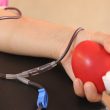The US Food and Drug Administration (FDA) has cleared the shockwave lithotripsy system to treat severely calcified plaque lesions. The device uses a balloon to release pressure sound waves capable of passing through the softest material, and possibly rupture calcified plaque and optimize stent implantation. As such, it has the potential to replace or, at...
Practical Management of Coronary Perforations
Coronary perforation has an incidence of 0.5% and it is associated with a 13-fold increase in in-hospital events and a 5-fold increase in 30-day mortality. This event is so catastrophic that its management has become indispensable knowledge to all interventional cardiologists. This accident is most frequently provoked by artery over-dilation caused by a balloon or...
TCT 2018 | SYNTAXES: 10 Year Follow Up is ‘Trendy’
The SYNTAX trial had a 5-year follow-up, but the SYNTAXES (“ES” for extended survival) was specifically designed to find out comparative mortality of both treatments (PCI or surgery) at 10 years in patients with three vessel and/or left main lesions. This study retrospectively compared survival data at long term of 897 patients randomized to surgery...
TAVR in Patients with Classical Low Flow, Low Gradient
Classical symptomatic low-flow, low-gradient (LFLG) severe aortic stenosis is associated with low survival rates at 3 years (<50%). However, in the medium term and with surgery, those rates improve (although mortality rates are 6%-30%, depending on the series). In patients without contractile reserve, surgical mortality is higher. Patient evolution in TAVR is still mostly unclear. ...
Keys to Productivity Improvement in the Cath Lab
The systematic reduction of inefficiencies in the catheterization laboratory (such as the improvement of lab room start times and room turnaround times) can definitely improve the productivity of a Department of Interventional Cardiology without forcing its members to stay in the facilities longer. As a matter of fact, work can be finished even faster with...
Frequency and Evolution of Cardiac Perforation in Patients with a History of MRS
Courtesy of Dr. Carlos Fava. Coronary perforation (CP) is a very uncommon event (≈0.4%), associated with severe complications that entail risk of death. It has usually been related to patients with a history of myocardial revascularization surgery (MRS). However, this group usually presents lower rates of cardiac tamponade due to pericardial fibrosis caused by surgery. This...
Mortality at one year in post PCI myocardial infarction
Courtesy of Dr. Brian Nazareth Donato. Multiple definitions with biomarkers and variable thresholds have been proposed to diagnose post procedural MI. The last update of the Third Universal Definition of Myocardial Infarction decided to use only troponin values with a threshold >5 over the normal value, on top of the clinical evidence by ECG, echocardiography...
Are 7 Fr Dedicated Transradial Introducers Safe?
Courtesy of Dr. Carlos Fava. The transradial approach has been proven beneficial for quite some time now, but certain scenarios require the use of a 7 Fr or 8 Fr introducer, which is a great limitation. This study included 60 patients who underwent complex angioplasty with the help of 7 Fr dedicated transradial (TR) introducer Glidesheath Slender (Terumo, Tokyo,...
Coronary Perforation in PCI: Associated to Negative Outcomes
Courtesy of Dr. Guillermo Migliaro. Coronary perforation (CP) is a rare but serious complication of percutaneous coronary intervention (PCI) with an estimated incidence of 0.5%. Arterial blood entering the pericardium may cause a rapid elevation of intrapericardial pressure and collapse the right cavities (tamponade) creating hemodynamic compromise. Historically, surgical drainage has been the...
Good outcomes of bioresorbable scaffolds in off-label cases
Original Title: Clinical outcomes following “off-label” versus “established” indication of bioresorbable scaffolds for treatment of coronary artery disease in a real-world population. Reference: Tadashi Miyazaki, et al EuroIntervention 2016;11:475-478. Courtesy of Dr. Carlos Fava. Bioresorbable scaffolds (BSB) have shown their benefit in different studies, but there is little information available on “off label”...








